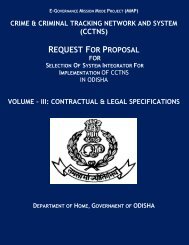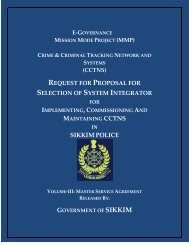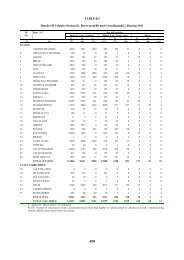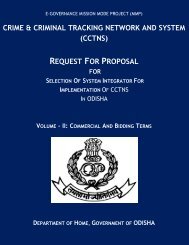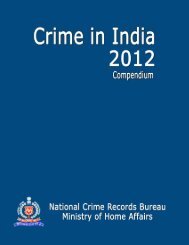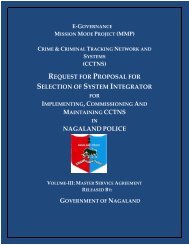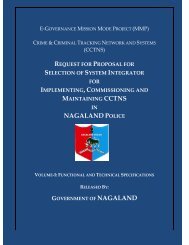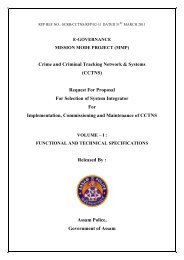EXPRESSION OF INTEREST - National Crime Records Bureau
EXPRESSION OF INTEREST - National Crime Records Bureau
EXPRESSION OF INTEREST - National Crime Records Bureau
- No tags were found...
Create successful ePaper yourself
Turn your PDF publications into a flip-book with our unique Google optimized e-Paper software.
E-GOVERNANCEMISSION MODE PROJECT (MMP)CRIME AND CRIMINALTRACKING NETWORK SYSTEM(CCTNS)<strong>EXPRESSION</strong> <strong>OF</strong> <strong>INTEREST</strong>TO SHORT-LISTS<strong>OF</strong>TWARE DEVELOPMENT AGENCY (SDA) FORCCTNS CORE APPLICATION S<strong>OF</strong>TWARE (CAS)NATIONAL CRIME RECORDS BUREAU (NCRB)MINISTRY <strong>OF</strong> HOME AFFIARSGOVERNMENT <strong>OF</strong> INDIA
1 Purpose of the EOI<strong>National</strong> <strong>Crime</strong> <strong>Records</strong> <strong>Bureau</strong> (NCRB), Ministry of Home Affairs (MHA), invites Expression ofInterest from interested professional Software Development Agencies (SDA) for a turnkey project to:a) Develop, enhance and maintain the CCTNS Core Application Software to be deployed atthe States (hereafter referred to as CAS).b) Develop, enhance and maintain the CCTNS Core Application Software to be deployedcentrally at <strong>National</strong> <strong>Crime</strong> <strong>Records</strong> <strong>Bureau</strong> (hereafter referred to as CAS (Centre))The selected SDA would be working under the guidance and supervision of <strong>National</strong> <strong>Crime</strong> <strong>Records</strong><strong>Bureau</strong> (NCRB), MHA, NIC and DIT. NCRB will host the Project at the Central Government levelon behalf of the MHA.The purpose of this EOI is to help NCRB determine the list of software development agencies thatwould be invited to respond to the RFP to be issued by NCRB on behalf of MHA. NCRB reserves theright to determine the list of software development agencies that would be invited to bid for theproject.2 Background on CCTNSA Common Integrated Police Application (CIPA) programme had been initiated in the year 2004-05to bring about computerization and automation in the functioning at the police station with a view tobringing in efficiency and transparency in various processes and functions at the police station level.Over a period of time, it was felt that a stand-alone system of this nature would have limited utility,and there was a need to expand the functional application and build in networking capabilities in thesystem. This was required both from the angle of Management Information Systems (MIS)requirements and storage, collation, analysis and transmission/sharing of crime and criminals relatedinformation at the police station, District, State and Central levels.4
2.1 Introduction to CCTNSThe Ministry of Home Affairs has conceptualized the <strong>Crime</strong> & Criminals Tracking Network andSystems (CCTNS) project as a Mission Mode Project under the <strong>National</strong> e-Governance Plan (NeGP).This is an effort of the Government of India to modernize the police force giving top priority toenhancing outcomes in the areas of <strong>Crime</strong> Investigation and Criminals Detection, in informationgathering, and its dissemination among various police organizations and units across the country, andin enhancing Citizen Services.CCTNS aims at creating a comprehensive and integrated system for enhancing the efficiency andeffective policing at all levels and especially at the Police Station level through adoption of principlesof e-Governance, and creation of a nationwide networked infrastructure for evolution of IT-enabledstate-of-the-art tracking system with the following objectives:Goals and Objectives of CCTNSi. Provide Enhanced Tools for Investigation, <strong>Crime</strong> Prevention, Law & Order Maintenanceand other functions like Traffic Management, Emergency Response, etc.a. Utilize IT for efficiency and effectiveness of core policing operationsb. Provide information for easier and faster analysisii.Increase Operational Efficiency by:a. Reducing the necessity to manually perform monotonous and repetitive tasksb. Improving the communication e.g. Police messaging, email systems, etc.c. Automating back-office functions, and thereby release police staff for greaterfocus on core police functionsiii.Create platforms at State and Central levels for sharing crime and criminal information/databases across states and across the country. This would enable easy sharing of real-timeinformation across police stations and districts at the State level and across states at the<strong>National</strong> level, there by resulting in:a. Improved investigation and crime prevention5
. Better tracking of criminals, suspects, accused, repeat offenders, etc.iv.Create a platform for sharing intelligence across the states, across the country and acrossother state-level and GOI-level agenciesv. Improved service delivery to the public/ citizen/ stakeholdersa. Access to police services in a citizen-friendly mannerb. Provide alternate modes of service delivery such as internet (for general requestssuch as NOC, for following up on statusc. Example ministry of external affairs, road transportThe Scope of CCTNSThe scope of CCTNS spans all 35 States and Union Territories and covers all police stations(approximately 14,000) and all higher police offices (approximately 6,000) in the country. TheCCTNS project includes vertical connectivity of police units (linking police units at various levelswithin the States – police stations, district police offices, state headquarters, SCRB and other policeformations) as well as horizontal connectivity (linking police functions at State and Central level toexternal entities). CCTNS also provides for a citizen’s interface to provide basic services to citizens.<strong>National</strong> <strong>Crime</strong> <strong>Records</strong> <strong>Bureau</strong> (NCRB) is the central nodal agency for CCTNS. The CCTNSproject covers all 35 states and union territories. Within the states, the 14,000+ police stations and6,000+ higher offices (including District HQ, Range Offices, Commissionerates, State HQ, etc.). Thefollowing are the suite of proposed solutions / modules for the Police Department (indicative):1. Registration, Investigation, and Prosecution Solutions2. <strong>Crime</strong> Prevention Solutions3. Reporting Solutions4. Collaboration Solutions5. Emergency Response Management Solutions6. Citizen and External Interfacing Solutions7. Traffic Solutions6
8. Law and Order SolutionsThe scheme would finance the following components under CCTNS: CCTNS application to addressthe police functionality under the scope of CCTNS, procurement and installation of hardware(including PCs and peripherals), connectivity infrastructure, state-level Data Centres, site preparationand commissioning, capacity building and handholding, digitization of historical data, data migrationfrom legacy systems (if any) and specialized applications and infrastructure (that are approved underthe CCTNS scheme).These components would be provided as a “bundle of services” to be executed by a SystemsIntegrator at state level. Funds would be released only against the procurement of the prescribed“bundle of services” and not against the procurement of individual components thereof.2.2 Implementation ModelThe Implementation Strategy for CCTNS has been devised keeping in view the followingconsiderations:• NeGP frameworks of centralized planning and decentralized implementation• Need for ownership of the State Governments of the overall program implementation, theinfrastructure, application and the database; at the same time maintaining uniformity ofinformation systems in order to facilitate information sharing and availability across states and atthe national level• Need to undertake the implementation of this large-scale project in a coordinated manner throughexperienced implementation agencies by entrusting them with the responsibility of end-to-endimplementation with a clear set of deliverables.• Need to synchronize the rollout of the hardware and network components with the rollout of otherequally important soft components such as training, capacity building and change management.Accordingly, CCTNS adopts a “bundling of services” approach to implementation. Accordingly, allthe implementation components at the state level are “bundled” and contracted out to a singleSystems Integrator (SI) who would act as a single point of contact and accountability for theimplementation and performance of CCTNS. The bundle of services would include the following:7
1. The SI would customize and implement CCTNS core application provided by NCRB2. The SI would develop and deploy additional functionality that is scoped under CCTNS(for some of the additional functionality, the central nodal agency would provide thefunctional specifications to ensure standardization across states).3. Procurement, installation and commissioning of hardware (including PCs, peripherals,etc.) at police stations and higher offices including site preparation4. Procurement, deployment and commissioning of communications infrastructure at allpolice stations and higher offices; building and commissioning of state Data Center5. Capacity building6. Change management7. Procurement, configuration and commissioning of specialized infrastructure andapplications as necessaryEach state would select a SI who would be selected by the state through a competitive biddingprocess. The SI would be held responsible for the outcomes of the program and their payments wouldbe linked to the progress of the project as well as the outcomes of the program.2.3 CCTNS Application SoftwareOn behalf of MHA, NCRB would provide all states with a CCTNS Core Application Software(CAS), which would be configured, customized, enhanced and deployed by the States. NCRB intendsto engage the services of a professional software development agency (SDA) to develop CAS thatwould be provided to all States. The State level Systems Integrators (SI) would configure, customizeand enhance CAS according to the unique requirements of the State before deploying it.The SDA would design and develop CAS based on the functional requirements specified by NCRB,and would also manage CAS. NCRB would select an SDA through a competitive bidding process, ofwhich the first step is the short-listing of software development agencies who would be invited to bidfor the development of CAS. The purpose of this EOI is to help in the short-listing softwaredevelopment agencies that would be invited to bid for CAS development.8
3 Outline of Scope of WorkThe SDA that will be selected through this EOI and subsequent RFP is expected to design, develop,and provide the Core Application Software for the States. The SDA will be responsible for supportingthe State Level System Integrator(s) for the final implementation of the developed Core ApplicationSoftware. The Core Application Software for the States will provide the limited but core functionalitythat is required at the Police Station. The remaining functionality will be developed by the StateLevel System Integrator(s) on top of the Core Application Software.The scope of this project covers design, development, testing, enhancements, training, maintenanceand user/technical support for the two main components of the CAS:i. CAS (State): CAS would be provided to States and Union Territories by NCRB, onbehalf of MHA. The Systems Integrators (SI) selected by the States would configure,customize, extend and deploy the State CAS per the unique requirements of each State.The SDA would be required to design, develop, test, enhance and maintain CAS. TheSDA would also be required to create all required documentation including operationsmanuals, technical manuals and user manuals. The SDA would be responsible forproviding training content, user/technical support, and deployment support to the SystemIntegrators at State Level for configuration and customization of the application.ii.CAS (Centre): This component is an application at the Central (GOI/NCRB) level thataccepts/gathers/ collects data from States and processes/ organises the same. CAS(Centre) would be deployed at NCRB. Relevant input, output and report formats andprocessing requirements would be included as per the requirements of GOI/ GOIAgencies. The SDA would be required to design, develop, test, enhance and maintainCAS. The SDA would also be required to create all required documentation includingoperations manuals, technical manuals and user manuals. The SDA would be responsiblefor providing training content, user/technical support, and deployment support to NCRBfor central deployment.9
CCTNS Core Application Software (CAS) would be built as a platform to provide the basicframework to capture crime and criminal information, mainly at the police station, while providingthe states with the flexibility to build their state specific applications around it and in addition to it.The SDA would build the CAS (State and Centre) based on the Functional RequirementsSpecifications (FRS) and Technical Architecture Guidelines provided by NCRB on behalf of MHAand its agencies. In doing so, the SDA would explore the option of leveraging to the extent possible,existing applications, including the applications at NCRB, State level applications or any otherapplications in this domain.Brief Functional Scope for the Core Application Software (State)The CAS (State) would focus on policing function at the State level and would be used at PoliceStations, District and other Higher Offices and other police formations. It would be a web-basedapplication designed to operate in low bandwidth and/or unreliable connectivity scenarios. CAS(State) would cover the following indicative functionality:a. Registrationb. Investigationc. Prosecutiond. Search/Query functionalitye. Reporting and MISf. Police messaging systemIn addition to the Core Application Software for the States, the SDA is expected to design, develop,and implement the Core Application Software for the Center. The Core Application Software(Center) will provide the required functionality to the NCRB for collating the information from thevarious states and provide the necessary reports to the NCRB.Brief Functional Scope for the Core Application Software (Center)This component is an application at the Central (GOI/MHA/NCRB) level that accepts/gathers/collects data from States and processes/ organises the same. It analyses and reports on policing10
information on a national scale, acts a hub for information exchange between states and with externalagencies and serves the information, analysis and reporting needs of MHA. CAS (Centre) would bedeployed at NCRB. Relevant input, output and report formats and processing requirements would beincluded as per the requirements of GOI/ GOI Agencies. CAS (Center) would cover the followingindicative functionality:a. Interfaces with States to receive, gather, extract, collate and organize crime- andcriminals-related datab. Carry out required analysis to serve the information, reporting and intelligenceneeds of MHA, other ministries and agencies, the Parliament and Citizens. CAS(Centre) would also share the results of their analysis with States and UnionTerritories.c. Interfaces with external entities such as Passports, Immigration to receive and sharedata with them.The CAS will be built for the GOI (with NCRB coordinating on behalf of MHA) for the minimumcommon functionality that is common across the States/ UTs and falls under the scope of CCTNS.The CAS shall be provided, along with its source code, to the States, for configuration,customization, enhancement and maintenance by the States (through the Systems Integrators to bechosen by the States). The CAS must be parameterized to accommodate the configurations requiredfor each State with respect to the common functions. The CAS has to be built as a platformindependentapplication so that it is easily portable across platforms i.e. the application should beportable across hardware, operating systems, database systems, enterprise platforms etc. It isenvisaged that CAS would be a web application based on hybrid architecture, designed to operate inlow bandwidth and/or unreliable connectivity scenarios. It is further envisaged that the CAS would bebased on a service-oriented architecture (SOA) to enable reuse of basic services.3.1 Outline of Scope of Services around CAS (State)The following are the indicative primary functions that will be undertaken by the SDA:1. Application Development of CAS (State)i. Conduct System Study/ Field Study for assessment and requirements gathering.11
ii. Preparation of System Requirements Specifications (SRS) based on the FunctionalRequirements Specifications (FRS) provided by NCRB on behalf of MHA.iii. Preparation of design documents including High Level Design and Detailed Designdocumentsiv. Development of CAS including User Interfacesv. Development of reports and forms.vi. Formulation of test plans.vii. Testing of the configured solution.viii. User Acceptance Testing and incorporating the feedback into the solution.ix. Final Testing of the solution including functional, stress, and load testing.x. Getting the solution certified through a third party agency identified by NCRB.xi. Project Management: the SDA would deliver CAS under the overall supervision ofNCRB, MHA and DIT/ NIC. The SDA would be responsible for preparing and adheringto the detailed project plan, pre-determined timeliness and quality of the various modulesof CAS.2. Data Migration Methodology and Toolsi. The SDA should prepare a Data migration plan identifying data migration requirementsand specifications for migrating data from the legacy and manual systems in operation atthe State level.3. Professional Services and Implementation Support for Deployment of CAS (State)i. Provide access to interim and final releases, including code and related documentationii. Provide installation instructions and instructions for general configuration of the systemiii. Provide server sizing, configuration, tuning, and any additional guidelines required for theState Level System Integrator for proper commissioning of the system.iv. Provide training (online content, presentations, classroom training) on the installation,configuration and deployment of CASv. Preparation of detailed and comprehensive documents including Operations manuals,Technical literature and training materials including training manuals, presentation decksand online materials.12
vi. Provide details of Application Configuration parameters and instructions for configurationof the samevii. Maintenance (bug fixes, release management) of CAS.viii. Develop an online MIS and repository for providing centralized access to all documents,manuals, code, updates, training content, and help documents.ix. Incorporate feedback from States to enhance the CAS.x. The SDA would help NCRB in developing the internal competency to take over themanagement of State CAS within a period of approximately 3 years from thecommencement of the engagement.4. Application Management Services for State CASi. The SDA would enhance and maintain (bug fixes, enhancements) the CAS for a period ofapproximately 3 years from the commencement of the engagement, after which NCRBwould takeover the management of State CAS.ii. The SDA should work with NCRB in preparing an exit management plan. This must bereviewed and updated regularly till NCRB takes over the management of the application.3.2 Outline of Scope of Services around CAS (Centre)The following are the indicative primary functions that will be undertaken by the SDA:1. Application Development of CAS (Centre)i. Preparation of System Requirements Specifications (SRS) based on the FunctionalRequirements Specifications (FRS) provided by NCRB on behalf of MHA and afterdetermining to what extent existing applications could be leveraged.ii. Preparation of design documents including High Level Design and Detailed Designdocumentsiii. Development of CAS (Centre)iv. Development of reports and forms as requiredv. Formulation of test plansvi. Testing of the configured solutionvii. User Acceptance Testing and incorporating the feedback into the solution.13
viii. Final Testing of the solution including functional, stress, and load testing.ix. Getting the solution certified through a third party agency identified by NCRB.x. Project Management: the SDA would deliver CAS under the overall supervision ofNCRB, MHA and DIT. They would be responsible for preparing and adhering to thedetailed project plan and the timeliness and quality of the various modules of CAS.2. Data Migration ServicesData migration services for migrating the data from the legacy and manual systems in operationincluding:i. The SDA should prepare a Data migration plan identifying data migration requirementsand specifications for migrating data from the legacy and manual systems in operation atthe Centre.3. Training Service for CAS (Centre)i. User training to different user groups at NCRB and SCRBs based on the nature of usageii. The SDA would help NCRB in developing the internal competency to take over themanagement of Center CAS within a period of approximately 3 years from thecommencement of the engagement.iii. Develop an online repository for providing centralized access to all documents, manuals,code, updates, training content, and help documents.iv. Provision of detailed and comprehensive documents for the above stages includingOperations manuals, User manuals and Technical literature and training materialsincluding training manuals, presentation decks and online materials.4. Implementation Support for CAS (Centre)i. The SDA would provide NCRB and any other agencies involved with CAS (Centre) allthe support necessary in deploying the application at NCRB. This support would includebut is not limited to helping create and test the production environment at NCRB,deployment of CAS (Centre), integration testing and acceptance testing.5. Application Management Services for CAS (Centre)14
i. The SDA would enhance and maintain the CAS (Centre) for a period of up to 3 yearsfrom the commencement of the engagement, after which NCRB would takeover themanagement of CAS (Centre).ii. The SDA should work with NCRB in preparing an exit management plan. This must bereviewed and updated regularly till NCRB takes over the management of the application.4 Pre-qualification Criteria for the SDAParticipation is invited from Software Development Agencies (SDA) who meet all of the followingcriteria.4.1 The participating Software Development Agency must be a single legal entity registered inIndia and must have a Registered Office in India. The company should have been operational inIndia for at least the last five financial years.4.2 The SDA should have been profitable for at least three of the last five financial years.4.3 The SDA must have a proven and consistent track record of successfully offering softwaredevelopment and related services. The SDA must have earned annual turnover of Rs. 250Crores or more from software development services during the last two financial years.4.4 The SDA must have been successfully assessed SEI CMMI Level 4 or above for IT Servicesand the certification must be currently held.4.5 The SDA must have at least 300 employees as part of their software services group, includingsoftware developers, architects, project managers, professional integration services andbusiness analysts (employees from sales and marketing, Human Resource, Finance,Administration and other corporate functions must not be counted). Please provide samplerésumé of at least 15 people who would be working on this project if awarded.15
4.6 The SDA must have designed, developed and maintained at least 2 applications/products eachwith a total software services value of Rs. 5 Crores during the last 5 years. These projects mustsatisfy the following additional requirements:4.6.1 The application/product must be web-based4.6.2 The application/product must have been deployed in at least 10 customers/sites withunique requirements, and must have successfully been configured, customized,enhanced and deployed to meet the unique requirements of eachcustomer/deployment site.4.6.3 The application/product must have been maintained for a minimum period of 1 year4.7 The SDA must have prior experience of working on at least 1 software services project forGovernment of India, any of the State/UT governments or Public Sector Units. The projectmust be worth at least Rs. 1 Crore.5 Conditions to be met by the SDA5.1 Considering the sensitive nature of the domain of the project and the data involved, it ismandatory for all short-listed companies to be security-vetted by MHA.5.2 The SDA must be able to commit to engaging with NCRB for at least 3 years. During thisperiod, all senior members of the project must continue with CCTNS.5.3 The SDA should agree to make presentations related to the information sought in the responseto this EOI, if so requested by NCRB. This will not be a paid activity; the SDA must be readyto undertake this activity on its own.5.4 The Software Development Agencies shortlisted on the basis of this EOI should agree todevelop and demonstrate a proof of concept, with basic functionality, if so requested by NCRB.The demonstrations would be part of the technical evaluation during the technical/ financial bidprocess and will not be a paid activity. The SDA must be ready to undertake this activity on itsown.16
5.5 Participants declared by MHA to be ineligible to participate for unsatisfactory pastperformance, corrupt, fraudulent or any other unethical business practices shall not be eligible.5.6 Breach of general or specific instructions for bidding, general and special conditions of contractwith MHA or any of its other client organizations during the past 5 years may make a firmineligible to participate in EOI bidding process.MHA reserves its right to subject the bidders to security clearances, as it deems necessary.6 Tentative TimelinesTentative timelines for the SDA identification are as follows:ActivityPublication of Expression of InterestPer EOI conference (If required)Last date for receipt of responsesTimelineTT + 1 weekT + 3 weeksT: Date of publication of EOI.NCRB reserves the right to modify these indicative timelines.7 Response requirementsInterested Software Development Agencies may furnish their Expression of Interest (EOI) by givingall the necessary documents in English as specified in the Response Formats for each of the abovementionedqualifying criteria as proof of having the minimum requirements. The Expression ofInterest in a sealed cover along with an application duly signed by an authorized signatory must reachthe following address on or before Aug 11 2009 by 1500 hours.Inspector General of Police (CCTNS)17
<strong>National</strong> <strong>Crime</strong> <strong>Records</strong> <strong>Bureau</strong>East Block – 7, R. K. PuramNew Delhi – 110066Email Address: projectcctns@ncrb.nic.inPhone: 91-11-26172324, 91-11-26105353NCRB reserves the right to withdraw this EOI if it is determined that such action is in the bestinterest of the Government of India. Short-listed SDAs would only be issued formal tenderenquiry/Request For Proposal inviting their technical and commercial bids at a later date. NCRBreserves the right to determine the shortlist of SDA based on the responses to this EOI. NCRBundertakes that all the information shared by the SDA will be held in strict confidence and will not bemade public unless directed by court of law.Respondents are requested to submit their responses in the format given below.a. Covering Letter as per the format provided in Appendix Ib. Requested information in the suggested formats along with the mandatory supportingdocuments for each of the criteria as provided in Appendix IIFor any queries related to this notice on Expression of Interest, an email may be sent toprojectcctns@ncrb.nic.in on or before July 27, 2009. “[EOI Query]” may be included in the subjectline.18
AppendixAppendix I: Covering letter from the Software Development AgencyCompany Letterhead[Date]Inspector General of Police – CCTNS<strong>National</strong> <strong>Crime</strong> <strong>Records</strong> <strong>Bureau</strong>East Block – 7, R. K. Puram,New Delhi - 110010Reference: Notice on Expression of interest to design, develop and maintain CCTNS CoreApplication SoftwareDear Sir,This is to notify you that our company intends to submit a proposal in response to the RFP fordesigning, developing and maintaining CCTNS Core Application Software.Primary and Secondary contacts for our company are:Name:Title:Company Name:Address:Phone:Mobile:Fax:E-mail:Primary ContactSecondary ContactWe confirm that the information contained in this response or any part thereof, including its exhibits,and other documents and instruments delivered or to be delivered to NCRB is true, accurate,verifiable and complete. This response includes all information necessary to ensure that thestatements therein do not in whole or in part mislead the department in its short-listing process.We fully understand and agree to comply that on verification, if any of the information provided hereis found to be misleading the short listing process or unduly favours our company in the short listingprocess, we are liable to be dismissed from the selection process or termination of the contract duringthe project, if selected to do so, for undertaking the design, development and maintenance of CCTNSCore Application Software.19
Should we be shortlisted after the evaluation of this response, we agree to have security vetting doneby MHA. We understand that we are liable to be dismissed from the selection process if anyassociation is revealed that may give rise to conflict of interests.Should we be selected to execute this project, we agree to engage with this project for a minimum of3 years. We also agree to ensure that the senior people staffed on this project would continue to beengaged with this project for a minimum of 3 years.We agree to abide by the conditions set forth in this EOI.It is hereby confirmed that I/We are entitled to act on behalf of our corporation/company/firm/organization and empowered to sign this document as well as such other documents, which maybe required in this connection.Dated this, _______ Day of ______________, 2009(Signature)(In the capacity of)Duly authorized to sign the EoI Response for and on behalf of:Sincerely,[S<strong>OF</strong>TWARE DEVELOPMENT AGENCY’S NAME]NameTitleSignatureDate(Name and Address of Company) Seal/Stamp of the SDACERTIFICATE AS TO AUTHORISED SIGNATORIESI, ……………………………………………, certify that I am …………………………… of…………………………………………………, and that……………………………………………………………… who signed the above response isauthorized to bind the corporation by authority of its governing body.(Seal here)Date20
Appendix II: INDEX <strong>OF</strong> FORMATS & SUPPORTING DOCUMENTSIf the responder is a single legal entity, they would be required to provide all relevant forms listedbelow. In case of a consortium, the lead participant firm would be required to provide all requestedinformation. All participating firms would be required to furnish their Certificates of Incorporationissued by the Registrar of Companies.Criteriarefers toparagraphRequested InformationForm I: Details of the Organization4.1Mandatory Supporting Documents1. Certificate of Incorporation from Registrar Of Companies (ROC)2. Relevant sections of Memorandum of Association of the company orfilings to the stock exchanges to indicate the nature of business of thecompanyForm II: Financial Information4.2Mandatory Supporting Documents1. Auditor Certified financial statements for the last five (5) financialyears, i.e. from 2008-09 to 2004-05 (if the results of 2008-09 are notready, provide information from 2007-08 to 2003-04). Please includeonly the sections on P&L and the assets, not the entire balance sheet.Form III: Information on Revenue from Software Services4.3Mandatory Supporting Documents1. Certification by the company auditors supporting the revenue breakupfor the last two financial years.4.4Form IV: CMM Level AssessmentMandatory Supporting Documents1. Copies of the CMM LEVEL assessments for the last three years.4.5Form V: Employee InformationMandatory Supporting Documents1. Attestation from the company auditor confirming the employeeprofile information. In case of consortium, attestations from auditors21
of all participating firms are required.2. Sample résumé of at least 15 people who would be allocated to thisproject of awarded.Form VI: Project Information (Web-based projects with multipledeployment instances)4.6Please use one form per project.Mandatory Supporting Documents1. Details for the relevant project(s)Form VII: Project Information (Government Experience projects)4.7Please use one form per project.Mandatory Supporting Documents1. Details for the relevant project(s)It is mandatory to provide all the information requested and failure to do so would be treated as noncompliance.NCRB undertakes that the information would be kept confidential until and unlessmandated by the Court of Law.22
Appendix III: Formats for ResponsesForm I: Details of the OrganizationNameNature of the legal status in IndiaNature of business in IndiaDate of IncorporationDate of Commencement of BusinessAddress of the HeadquartersAddress of the Registered Office in IndiaOther Relevant InformationForm II: Financial InformationRevenue (in INRCrores)Profit Before Tax (inINR Crores)FY2008-09FY2007-08FY2006-07FY2005-06FY2004-05Form III: Information on Revenue from Software Development ServicesRevenue from Software DevelopmentServices(in INR Crores)FY 2008-09 FY 2007-0823
Form IV: CMM Certification InformationLevel of CMM CertificationDate of AssessmentUnits/Locations AssessedName of the Assessing company and theircontact coordinatesForm V: Information of Employees and Skill SetsEmployee ProfileTotalProject ManagersTechnical ArchitectsBusiness AnalystsSoftware developers with Database designexperienceSoftware developers with web-based serviceoriented application design experienceSoftware developersTesting and Quality AssuranceExperienced in Graphical User Interface designand UsabilityProfessional Services Team for Integration andapplication deploymentTotalSupporting Documents1. Certification by the company auditors supporting the employee informationprovided above2. At least 15 résumé of people who would be working on this project ifawarded.Other Relevant Information (if any):24
Form VI: Information on Prior Experience in building web-basedapplications/products with multiple unique instances of deployment (one form foreach project reference duly certified by authorized signatory)Client InformationName of the clientDetails of the Client’s contact person for reference.Please include name, designation, postal address, contactphone, fax number and e-mail idAny relevant details about the client organizationProject DetailsNature of the ProjectTotal Contract Value for Software Development ServicespartPlease provide a description of the project including thegoals of the project, scope of the project, roles of the teammembers involved, uniqueness of the project, complexityof the project, significant achievements and any otherdetail considered significant.Geographical Locations of ImplementationPresent status of the projectNumber of Locations/Units at which the project isimplementedPeak project team size of the SDA during developmentPeak on-site (at the client location) project team size ofthe SDA post-implementation. Please provide the breakupinto different teamsDate of commencement of the projectDate of successful completion of the project.If the project is not completed, please provide dates of keymilestones already achieved and target dates forupcoming key milestones up to and including theexpected date of completion.Scope of the SDA’s Engagement (software development,infrastructure procurement, training, etc.)Duration of maintenance supportDetails of the Solution25
• Number of Instances of deployment of the solution• Technical Details of the solution:(web-based deployment, nature of configurability ofthe solution)Relevance of the implementation to the current projectOther Relevant InformationForm VII: Information on Government Project Experience (one form for each projectreference duly certified by authorized signatory)Client InformationName of client (Government Department)Country of Client/application deploymentDetails of the Client’s contact person for reference.Please include name, designation, postal address, contactphone, fax number, e-mail idAny relevant details about the ClientTotal number of Employees of the client organization(department/ministry/PSU)Project DetailsNature of the Project including the government domainand nature of engagementTotal Contract Value of the projectPlease provide a description of the project including thegoals of the project, scope of the project, and any otherdetail considered significant.Present status of the projectDate of commencement of the projectDate of successful completion of the project.If the project is not completed, please provide dates of keymilestones already achieved and target dates forupcoming key milestones up to and including theexpected date of completion.26



